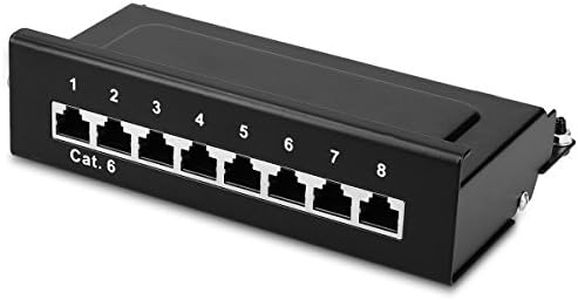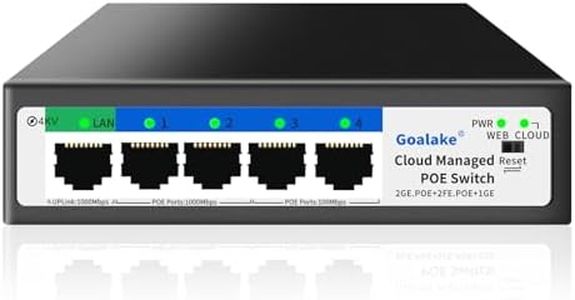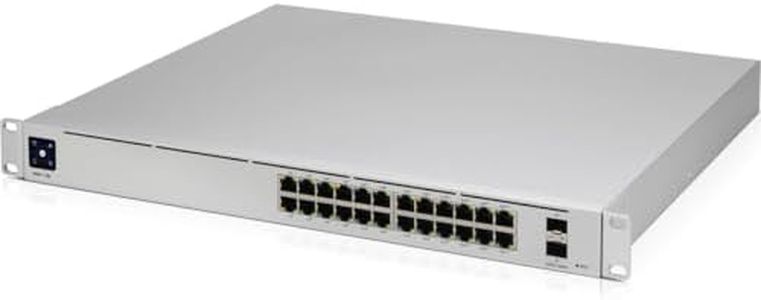10 Best Ethernet Switches 2025 in the United States
Our technology thoroughly searches through the online shopping world, reviewing hundreds of sites. We then process and analyze this information, updating in real-time to bring you the latest top-rated products. This way, you always get the best and most current options available.

Our Top Picks
Winner
HPE Networking Instant On Switch Series 1960 48-Port Gb Smart-Managed Layer 2+ Ethernet Switch with PoE | 48x 1G | 2X 10GBase-T, 2X SFP+ | 40x CL4, 8X CL6 PoE 600W | Stackable | US Cord (JL809A#ABA)
Most important from
15 reviews
The HPE Networking Instant On Switch Series 1960 is a smart-managed Layer 2+ Ethernet switch that’s particularly suitable for growing businesses. With its 48 gigabit ports and additional 10G uplink options, it offers robust connectivity and sufficient power for devices like IP cameras and phones through its Power over Ethernet (PoE) capabilities. The PoE function is particularly strong, providing 600W across 40 ports, which is great for powering multiple devices without needing extra outlets.
One standout feature is the ability to stack up to four switches, allowing easy expansion of network capacity while managing them from a single IP address. This can simplify operations for businesses that anticipate growth. The user-friendly setup and management options through the mobile app or web browser mean that even users without technical expertise can get their network running smoothly.
There are a few considerations to keep in mind. While it is stackable, managing multiple devices might still require some level of familiarity with networking concepts, which could be a hurdle for absolute beginners. Additionally, the weight and rack-mounted design mean it might not be the best fit for users needing a compact or easily portable solution. The product's price point may also be higher than basic unmanaged switches, so it's best for those who need smart-managed capabilities and PoE support.
Most important from
15 reviews
HP JL255A E Aruba 2930F 24G PoE+ 4SFP+ Switch
The HP JL255A E Aruba 2930F switch is designed to meet the needs of small to medium-sized business networks that require reliable and efficient connectivity. With 24 ports, this switch allows for ample connections, making it suitable for environments where multiple devices need to be networked together. The inclusion of Power over Ethernet (PoE+) capability is a significant advantage, as it enables users to power devices like IP cameras and phones directly through the Ethernet cable, eliminating the need for separate power supplies.
In terms of management, this switch is a managed device, which means users have access to advanced features such as VLANs, network monitoring, and security settings. This is particularly beneficial for IT professionals who need to have more control over their network environment.
The switching capacity is robust, ensuring that data is transmitted efficiently across connected devices, which is crucial for maintaining performance as network traffic increases. It’s worth noting that this switch does come with a slightly higher price point compared to unmanaged switches. For users who are simply looking to expand their network without the need for advanced features, an unmanaged alternative might be more cost-effective. The form factor is also practical, fitting well in standard server or network racks. However, potential buyers should ensure that they have enough space for this switch in their setup.
The HP JL255A E Aruba 2930F is a solid choice for those needing a feature-rich managed switch with PoE capabilities, making it ideal for businesses looking for scalability and enhanced network management.
Aruba a Hewlett Packard Enterprise company 6100 48G Class4 PoE 4SFP+ 370W Switch - JL675A#ABA US Localization/Cord
The Aruba 6100 48G Class4 PoE 4SFP+ 370W Switch is a solid choice for businesses looking for a managed Ethernet switch with a robust feature set. With 48 ports, it caters well to medium to large networks, allowing numerous devices to connect simultaneously. The Class 4 Power over Ethernet (PoE) support is a strong point, enabling power delivery to connected devices like IP cameras and VoIP phones without needing extra power sources. Additionally, the switch operates at layer 2, providing essential management features for improved network control and performance.
One of the highlights is its high switching capacity, which translates to efficient data handling across a busy network. The compact metal case also makes it durable, ideal for various environments.
However, being a managed switch, it may require some technical know-how to fully leverage its capabilities. Users who prefer a plug-and-play option without the need for extensive configuration may find this slightly challenging. Furthermore, while its weight is manageable, it's essential to consider the installation space, as it might take up more room than simpler, unmanaged switches. Lastly, the power capacity of 370W is impressive, but potential buyers should ensure this meets their specific needs, especially if they plan to power multiple devices.
The Aruba 6100 48G is an excellent option for network environments where management and PoE capabilities are essential, but it might not be the best fit for users seeking a straightforward, unmanaged solution.
Buying Guide for the Best Ethernet Switches
Choosing the right Ethernet switch for your network can significantly impact the performance and reliability of your connections. Ethernet switches are essential devices that connect multiple devices within a local area network (LAN) and manage data traffic efficiently. To select the best Ethernet switch for your needs, you should consider several key specifications that will determine how well the switch will perform in your specific environment.FAQ
Most Popular Categories Right Now



















